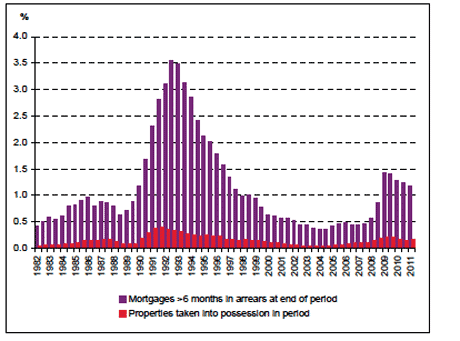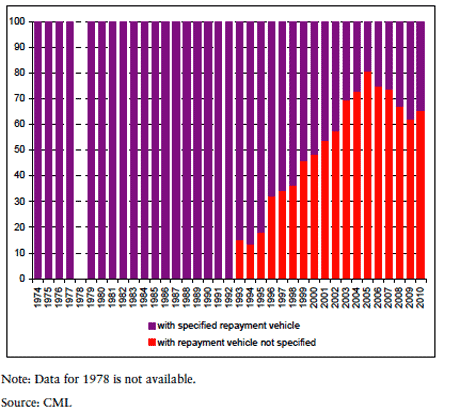Britain’s housing market is rotting from within
With mortgage approvals at record highs since the crisis began, Britain's housing market appears to have turned a corner. But in fact, the worst is yet to come, says Phil Oakley.
Has Britain's housing market turned the corner? Last week, the Council of Mortgage Lenders (CML) seemed quite upbeat.
It pointed to strong increases in property sales in recent months: January's mortgage approval levels were the highest since late 2009. "The underlying picture for house-purchase activity continues to show some buoyancy".
Others are more upbeat too. RICS members no longer expect further falls in house prices; throw in the more optimistic price outlooks from housebuilders and you might think that the market has bottomed.
MoneyWeek
Subscribe to MoneyWeek today and get your first six magazine issues absolutely FREE

Sign up to Money Morning
Don't miss the latest investment and personal finances news, market analysis, plus money-saving tips with our free twice-daily newsletter
Don't miss the latest investment and personal finances news, market analysis, plus money-saving tips with our free twice-daily newsletter
But don't bet on it. Recent studies of the mortgage market by the Financial Services Authority suggest there is a lot to worry about.
Have a look at the chart below. Property market bulls point out that mortgage arrears and house repossessions have peaked at much lower levels than during the crash of the early 1990s.
Proportion of UK mortgages in arrears of more than six months, plus repossessions

(Source: FSA Dec 2011 Mortgage Report)
On the face of it, this is true - for now. However, these statistics don't tell the whole story.
Repossession data doesn't tell the full story
Ironically, repossessions and arrears have been less pronounced during this crisis because the economic crash was so much worse than the 1990s downturn.
Because British banks have been in such a fragile state, the government and mortgage lenders have gone to huge lengths to stop a tidal wave of repossessions.
So, to get the full picture, the impact of these measures needs to be considered too.
According to the FSA, 5-8% of all mortgages are subject to some form of forbearance. This means that borrowers who are finding it hard to make their monthly mortgage payments are given some help.
This might mean moving to an interest-only mortgage, reducing your monthly payments, taking payment holidays or increasing the term of your mortgage.
These mortgages aren't included in arrears statistics and so the headline statistics on distressed mortgages need to be taken with a hefty pinch of salt. Particularly as, even when help is given, lots of mortgage-holders are still struggling.
In its recent report on mortgage lending, the FSA looked at the performance of loans in arrears. It showed that the payments received as a percentage of normal payments due were down to 58.3% (eg, £583 paid when the normal monthly payment should have been £1,000).
The UK is full of mortgage prisoners'
Another worrying statistic from the FSA is the number of so-called mortgage prisoners'. It estimates that nearly half the borrowers who took out a mortgage between 2005 and 2010 cannot remortgage to a better deal.
This is mainly because they have very high loan-to-value (LTV) mortgages which lenders are now very afraid of you need deposits of 40% to get the best deals at the moment. These borrowers may face higher mortgage rates when introductory deals come to an end. Can they cope?
On top of this, the FSA estimates that 15% of these borrowers could have mortgages that are greater than the value of their properties the dreaded negative equity.
All these mortgage prisoners and their lenders have the potential to add extra stress to the housing market when mortgage rates increase.
The interest-only time bomb
Last - but not least we have the huge problem of interest-only mortgages. Forget about house-price-to-earnings ratios and rental yields as measures of affordability.
If ever anything highlighted the scale of Britain's house-price bubble and the lack of affordability, it is the market for interest-only mortgages.
There is nothing wrong with an interest-only mortgage as long as you have the means to repay the mortgage as well. However, as house prices in Britain went higher during the boom, people increasingly took out interest-only mortgages with no real idea of how they would pay back the original capital.
As you can see from the chart below, at the top of the market in 2007, a quite incredible three quarters of interest-only loans taken out had no repayment plan backing them.
Borrowers and lenders alike were foolishly betting on higher house prices to pay off the mortgage. It is not surprising that lenders such as the Nationwide now require a deposit of 50% before granting an interest-only mortgage, and have been tightening their criteria since the start of this year.
Repayment vehicles and interest-only mortgages

These mortgages are a big problem for lenders. They account for 36% of all mortgages outstanding (43% if you include buy-to-let mortgages). During the nextten years, 1.5 million interest-only mortgages with a value of £120bn (10% of all outstanding mortgages) are due to be repaid. How?
Who knows? Some will be backed by sensible repayment plans, but we wouldn't be surprised if many have to be extended, putting further stress on lenders and borrowers.
What does this mean?
Clearly, the mortgage market and by extension the housing market is far from healthy. On top of the problems we've highlighted, unemployment is going up, fuel prices are stretching household finances and mortgage rates are rising.
People who can are rushing to fix their mortgages, but only 28% of all mortgages are fixed. Banks are likely to have to pay more to fund their mortgage lending (note that rates on individual savings accounts have been rising), and this means higher mortgage rates for lots of people. With so many borrowers having difficulty with mortgage rates at just 4%, any increase in rates is likely to hurt significantly.
Worse still, the weak housing market and distressed mortgage holders remain a drag on the UK economy. America is hardly booming, but its nascent recovery has at least in part been helped by the fact that house prices were allowed to fall, and so its banks have arguably been through the worst.
The problem with the UK is that the housing market and the banks are two sides of the same coin. If the housing market falls to sensible levels of affordability, then the banks will be in trouble.
Because economic policy seems to be targeted at protecting the banks (through quantitative easing, etc), the housing market is taking longer to correct but it's likely to be a harsher correction when it does. The housing market has been held up by cheap money, but it's rotting from within it's only a matter of time before it crumbles.
Get the latest financial news, insights and expert analysis from our award-winning MoneyWeek team, to help you understand what really matters when it comes to your finances.
Phil spent 13 years as an investment analyst for both stockbroking and fund management companies.
After graduating with a MSc in International Banking, Economics & Finance from Liverpool Business School in 1996, Phil went to work for BWD Rensburg, a Liverpool based investment manager. In 2001, he joined ABN AMRO as a transport analyst. After a brief spell as a food retail analyst, he spent five years with ABN's very successful UK Smaller Companies team where he covered engineering, transport and support services stocks.
In 2007, Phil joined Halbis Capital Management as a European equities analyst. He began writing for MoneyWeek in 2010.
-
 The most influential people of 2025
The most influential people of 2025Here are the most influential people of 2025, from New York's mayor-elect Zohran Mamdani to Japan’s Iron Lady Sanae Takaichi
-
 Millions of parents are missing out on up to £720 a year in extra pension cash – are you affected?
Millions of parents are missing out on up to £720 a year in extra pension cash – are you affected?A mum who narrowly missed out on the pension boost said she “never knew the government rule existed” and wants other parents to use it